QuestionQUESTION: Hi, I just bought 2 baby bearded dragons I have them in a 20 gallon tank with a basking area of about 95 degrees and humidity levels are between 45 to 55 degrees plus a half long for some shade. I am feeding them separately and in a different cage than i have them in plus they have fresh greens in there cage every day. One eats almost a dozen crickets a day, the other eats only 1 or 2 if that. Now the one that only eats 1 or 2 has not eaten anything in 3 days what can i do?
ANSWER: Hi Martin,
I am going to include a basic care sheet that I wrote to help people out with the care of their beardies. I find it important since most pet stores have no idea as to the care a reptile needs that they are selling.
I'm glad to see you are feeding greens..very important to their diet.
If you don't know the sex of your dragons, you may have two males and the one is bossing the other, even if you don't see it. This can also happen with two females. The bad part is that if you have two males they will never get along and will fight til death. Two females MAY get along forever...or never or for a few months.
I suggest each have their own set up regardless of sex and that way it will eliminate any question as to one bullying the other.
Your basking temperatures are a bit off..not a lot, but they should be in a gradient of 95-105 degrees. Your humidity doesn't need to be that high as they don't require a high humidity which actually too high can cause respiratory infections.
The one that isn't eating may be younger and as I said, may be being bullied. He is also most likely stressed from being in a new home. Many times, beardies are some before they should be. They really should not be sold until they are at least 6 inches in length.
Is it he doesn't want to chase the crickets? If yes, you can break the hind legs on the crickets which will prevent them from jumping.
Its very important to keep him well hydrated. Offer water from an eye dropper. You can also offer some baby food from a syringe.
If you are using sand or any other loose substrate I do recommend removing it as they can accidentally ingest it which will cause impaction and or blockage.
With reptiles, they all have internal parasites. A low level is actually needed for proper digestion. When that level is greater than needed, it can cause them to go off food. I suggest a vet visit to have a fecal check done. Stress can cause a parasite overload.
Try hand feeding the one that doesn't want to eat.
Keep an eye on his..is he basking in a good spot so that he is getting a good amount of heat? Does he seem to always be on the bottom with the other beardie on top? Does the other seem to be at the food dish first? Maybe standing tall when the other comes near the dish? If yes to any one of those questions, you have a bully issue, or two males.
Is he pooping? Also, I would give him a bath in a warm shallow pan of water. You don't want the water any deeper than his elbows when laying flat. This will give him a chance to drink if he wants and will also add some hydration to him.If after checking all your care and you also find its not a bully / two males issue, and he still doesn't start to eat in another day or two, then a vet visit is needed. The vet may suggest feeding via a syringe filled with a nutritional product such as CRITICAL CARE. You can also offer him some BeneBac or NutriBac or Acidolphliz+.
Those products add beneficial bacteria to their systems which, again, stress can decrease the needed bacteria for digestion.
BASIC BEARDED DRAGON CARE:
HOUSING:
For an adult bearded Dragon, a 50 -55 gallon is the smallest recommended tank. For a baby, nothing less than a 30 gallon tank will work for a very short time, so its best to just start out with the adult sized tank....you can add rocks and branches for climbing, being sure to not stack rocks too high to prevent them toppling over. Branches need to be secure. They like to have a hide log or cave too!! All items brought from outside need to be cleaned well before placing them in the BD's tank. To clean them, there are a few methods: to wash in a bleach solution of 1/4 cup of bleach to 1 gallon of water. Let them soak for about an hour, rinse them in hot water several times and then let them dry in the sun until completely dry. If the items are small enough, they can be baked in an over at 200 degrees for about 2 hours, check often to be sure they are not starting to burn. The items can also be boiled(simmered) for 30 minutes or so and then allowed to dry completely before placing in the tank. I also suggest washing any pet store items such as caves, rocks, branches, etc before placing in the tank as that if the store would happen to have mites they can also be on the items we purchase. Any of the above methods are acceptable for cleaning. CAUTION!!! On store bought branches...be VERY careful with the driftwood pieces that have the holes in them!!! Be sure the holes are small as that if the holes are large, the BD MAY be able to get his head in them but not able to get it back out!!! A secure screen top is necessary for bearded dragons as that also they do not require much height for climbing..they can and do climb!! NEVER USE HEAT ROCKS OR HEATED CAVES!!! They malfunction and cause severe burns and even death!!!!
SUBSTRATES:
Young bearded dragons MUST be kept on paper towels, newspaper or other non particulate(loose) substrate to prevent them from getting any loose substrate into their mouth and swallowing it which can and does cause intestinal blockages.Once the BD is over 10 inches, some people have had good luck using play sand mixed with 50% of peat moss. I prefer the safe substrate of the newspaper, or other non particulate substrate to prevent any problems and also for ease of cleaning.
LIGHTING:
BD's need UVB, which is the special lights that come in fluorescent tubes or special screw in bulbs(mercury vapor)that are designed to produce uvb and heat. The tubes do not produce heat. UVB is needed by the BD to be able to absorb the calcium in the foods they eat. Without the uvb, they will develop metabolic bone disease. With the tubes, they must say that they produce BOTH uvb and uva. The uvb needs to be 5% or higher. Repti Sun 5.0 and 10.0(not compact) are TWO of the best uvb tubes on the market. The repti glo 8.0's are a great uvb source also. Arcadia 5.0 (UK), which is the uvb tube available in the UK is a good uvb tube. These need to be positioned 6-8 inches(for the 5.0 and 8.0 and 8-10 inches for the 10.0) over the BD so that they get the uvb that is needed. Recommended length of the tube is 24 inches or more. They need to be replaced every 6-9 months as that they stop producing uvb long before they stop producing light. They need to have access to uvb and basking temperatures for 10-12 hours daily. At night, no white lights!!!
There has been new studies that have proven that compact uvb lights, both the spiral/coil type and the ones that look like long "U's" laying on their side and a few other brands are causing what basically amounts to snow blindness in reptiles. The companies have corrected the problem but, there may still be some of the earlier manufactured bulbs out there so be sure to double check what you are using, or even if you are using proper uvb source. To read more on this, you can go to
http://www.uvguide.co.uk/index.htm
The companies have been working to correct the problem with the lighting so its important to know if the light you have MAY be the old version.
This link will take you to my discussion group and to a post that tells how to tell the new compacts from the old ones. http://pets.groups.yahoo.com/group/UVB_Meter_Owners/message/6721
There are tubes and bulbs that say ''full spectrum'' but they do not produce any uvb.
On the mercury vapor , they also produce heat. They also produce the uvb and uva. The best on the market now are the MEGA RAY or the T-Rex. www.reptileuv.com has more information on the Mega Ray lights. When using these, the distance is much greater than the uvb tubes and the directions must be followed that are listed for the light. When using the mercury vapor lights, you don't need to have one light for uvb and one for heat. The Mercury vapor lights provide both.
HEATING AND TEMPERATURES:
Bearded Dragons have specific temperature requirements. For heat when using the uvb producing fluorescent tubes, a regular household light bulb will work for DAYTIME heat. The wattage needed will vary to each situation such as tank size, room temperatures, air flow. Their basking area temperature must be between 95F and 105F degrees to allow proper digestion of food. Your basking area must be where the uvb light is as well as the heat source. Be sure that the BD cannot get too close to the heat source as that they WILL get burned! The ambient temperature range in the mid 80's . Cool daytime range of normal room temperature of low to mid 70's. Nighttime temperatures in the low to mid 60's is fine. NEVER USE HEAT ROCKS!!!!!!!!!!!!!!!!!!!!! A good digital thermometer is a must. I like using the duel ones with the probe...cost about 15$ at Wal Mart. The probe can be placed in the basking area at the BD's level to monitor this temperature and the main unit can be placed in one of the ambient temperature areas. When reading them, the "out" reading is the probe area.
DIET:
Bearded Dragons eat and need both animal proteins and vegetable matter!!! As young dragons they eat a bit more of the insects. As they get older, as adults their diet is more of the vegetable matter. As young BDs, the diet is about 80% animal proteins and 20% vegetable matter. As they get older, the ratio changes. An adult will eat about 80%-90% vegetable matter and 10-20% animal proteins.
Animal protein sources are: Crickets, superworms, silkworms, roaches, hornworms, waxworms. Waxworms are considered candy to a BD so only feed on occasion in a small amount(2-3 worms). ALL insects must be properly gutloaded for at least 48 hours prior to feeding to the dragon. For crickets and superworms, this can be done with vegetables, plain cereals and commercial foods for the species. Silkworms and the other insects have their own diet needs. Its best to feed the crickets in a separate feeding tank such as a 10 or 20 gallon size tank or container with a well vented lid. This can make it easier for the dragon to catch the crickets and prevents any stray crickets in their "home" tank from deciding to nibble on the BD if he happens to not find them all. If you do feed in his home tank, be sure to place a 1/2 potato in the tank to help prevent the crickets from biting at the BD. ALL insects fed must be no larger than the space between their eyes to prevent choking. Be
sure to dust the insects daily(for dragons up to 14-15 inches) (2x wkly there after)with a good calcium source such as Rep Cal calcium powder with no added Phosphorus. Young BD's up to 4 months of age will eat more crickets than anything. At this age they will usually consume anywhere from 10 to 30+ correctly sized crickets three times a day. Be sure to remove any uneaten crickets that are not consumed in a 15-25 minute time frame. For this reason, its easier to use a separate feeding tank for the bearded dragon. A 10 gallon tank(with a screen top) works well. Its best to offer their "salad" of greens/veggies before offering their morning insect feeding when they are hungry to prevent any problems with them preferring NOT to eat their salad. Their salad consists of Collard greens, mustard greens, turnip greens, dandelion greens...... this is the BASE of the green part of their vegetable diet. To this, for variety you can add arugula, escarole, endive,small amounts of
bok choy or other Asian greens. For the vegetable part of the diet, green beans, butternut squash, acorn squash(other winter squashes are also acceptable) yams, sweet potato. For color, sweet peppers can also be added in a small amount. For baby BD's, using a food processor for the greens and veggies works well. As they get older, greens should never be larger than about an inch x an inch in size. Never feed lettuces as they have no nutritional value. The hard veggies should be either food processed or grated. Fruits can also be offered in small amounts. Good fruits are figs, papaya, melon, blueberries, strawberries, raspberries....and many other fruits... these need to be mashed or chopped. Watermelon is a good source of water for the dragon. Their salad can be dusted once or at the most, twice a month with a good vitamin supplement such as RepCal HerptiVit. This is by no means a complete list of foods the dragons can eat.You can also offer baby food chicken or
small bits of boiled chicken.
Be sure to provide a dish of FRESH drinking water at ALL times!!! Misting their salad will also help get much needed water into them. NEVER FEED any MICE or other mammals to your Dragon!!!
WATER:
As stated above, always provide a dish of drinking water and mist their salad. You can also bathe your dragon a few times a week. (many bathe them daily for "bathroom duties") Temperature of the water should be between 85 and 95 degrees. The depth should never be any deeper than to cover his back when laying FLAT!!! Never leave them unattended at bath time to prevent possible drowning. Many love to soak and swim for 15 minutes or more. Never bathe less than two hours before his basking lights go out. Doing so can cause him to become too chilled, risking the chance of a respiratory infection.
A vet check up is recommended and a fecal sample taken in to be tested for any internal parasites.... To find a qualified vet in your area you can go to
http://www.herpvetconnection.com
http://www.arav.org/ECOMARAV/timssnet/amm/tnt_mdsearch.cfm
http://www.anapsid.org/vets/
More in-depth care info can be found at:
http://www.bio..miami.edu/ktosney/file/BDcare.html
http://www.sundialreptile.com/care%20sheet--bearded%20dragon.htm
http://www.blackninjakitty.com/herps/dragons
Most bearded dragons will take long naps (generally,if they are over a yr) in the fall.. this is called Brumation. is a form of hibernation. You can read more about that at
http://www.exclusivedragons.com/Brumation.html be sure to read this link as it tells you what to look for in brumation vs illness.
http://www.bio.miami.edu/ktosney/file/BDbrumate.html
http://worldofbeardeddragons.blogspot.com/2006/11/bearded-dragon-brumation-bruma
---------- FOLLOW-UP ----------
QUESTION: What are the best types of greens to feed baby beardies?( I am feeding them chopped up broccoli) I think that they are a male and female due to the difference in size but I'm not sure. Can you suggest some different live food they might like other than crickets? Bulling is not really an issue as I feed them separately. What is the optimal hydration temp for a 20 gallon tank with 2 dragons
AnswerHi Martin,
Chopped broccoli isn't a good green to feed the beardies. It is a food that is only fed in small amounts on a rare occasion, if at all as that it can cause thyroid problems.
In the care sheet I sent you previous, there is a list of good greens to offer plus several other insects that can be fed. If they still are not eating, its important to find out why. Please read very carefully the care sheet and print it out so you can refer to it more easily. Double check all your care, especially the temperatures and uvb. You do need to plan on a much larger tank very soon if you plan on housing the two together(if they get along) and if they need to have their own tanks, again, much larger tanks will be needed soon...
As to the humidity level, normal room humidity is fine. This would be in the area of 30% or so.
Bathing a few times a week is good for your beardies as is misting them once a day.
Please don't base their sex on their size difference when they are babies as they may be of different ages and also grow at different rates. Also, I want to mention that if they are indeed from the same batch of eggs, then its even more important to never breed them as that can and does lead to unhealthy offspring. If there are any problems in the "lines" of the parents, it will come out very strong in the offspring. It can create weak offspring.

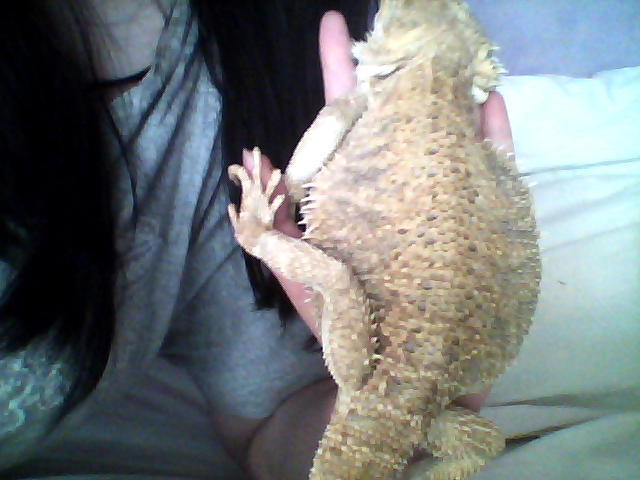 New bearded dragon hi tracie
Question
little skinny perhaps
Hi Tracie...
I tried to
New bearded dragon hi tracie
Question
little skinny perhaps
Hi Tracie...
I tried to
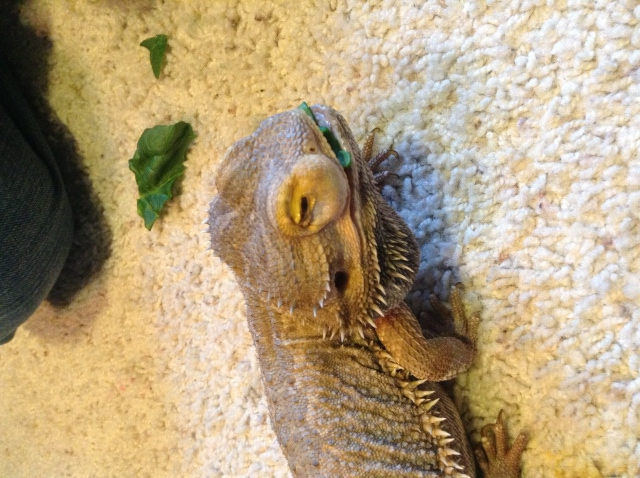 Rex hypovitaminosis A
Question
Rex Rex
This is the picture of hi
Rex hypovitaminosis A
Question
Rex Rex
This is the picture of hi
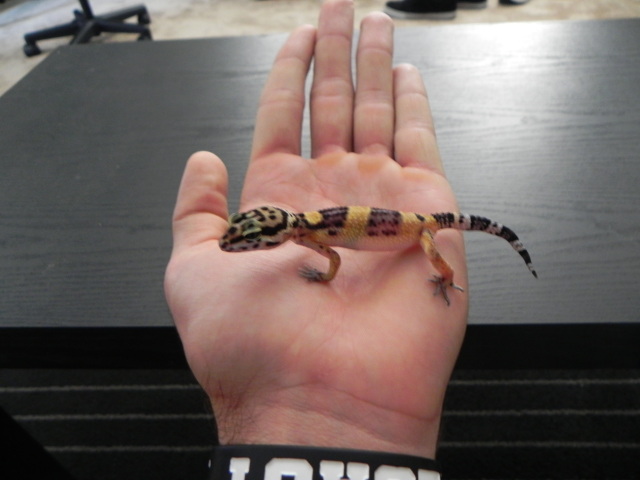 Leopard Gecko... Parasites ?
QuestionMy Gecko
QUESTION: HI Tracie,
I recentl
Leopard Gecko... Parasites ?
QuestionMy Gecko
QUESTION: HI Tracie,
I recentl
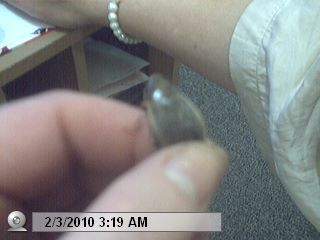 little lady
QuestionQUESTION: hi,i tried to send you a follow up on
little lady
QuestionQUESTION: hi,i tried to send you a follow up on
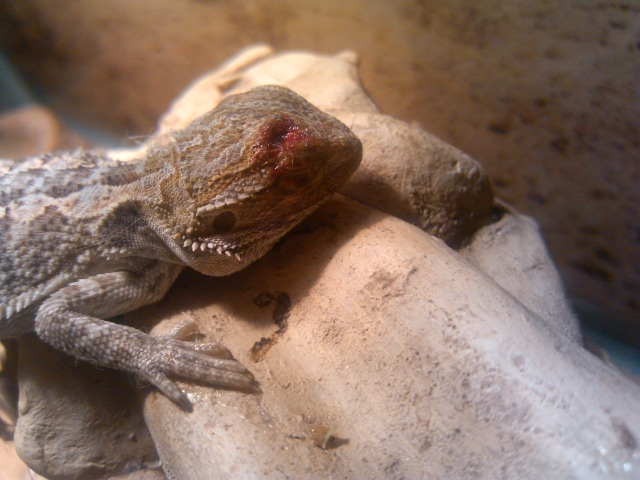 Bearded Dragon eye/head injury
Question
head injury head injury
Please h
Bearded Dragon eye/head injury
Question
head injury head injury
Please h